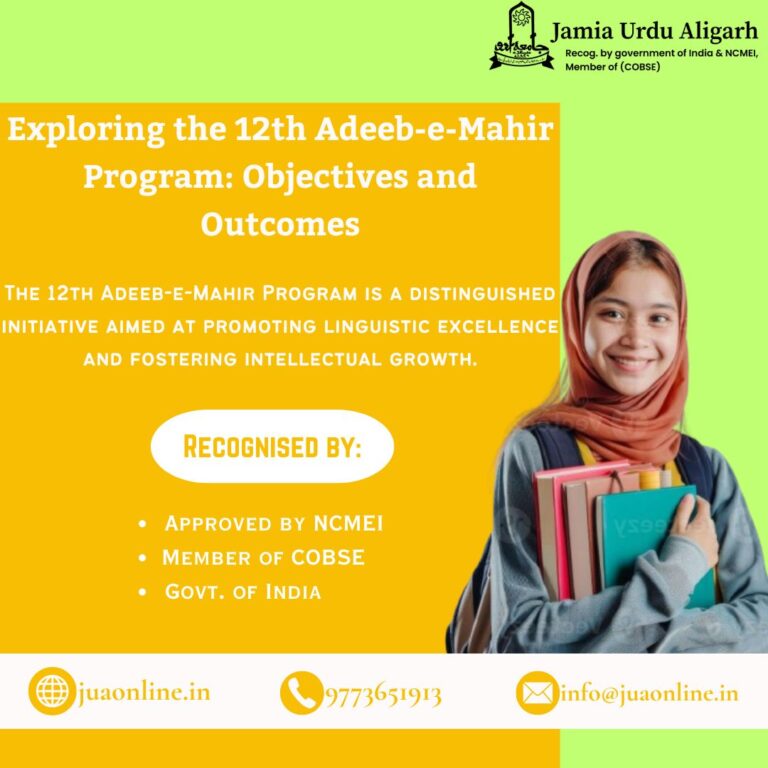The world of Urdu education has a rich legacy, deeply embedded in cultural and literary heritage. Among notable initiatives in this domain is the “12th Adeeb-e-Mahir Program,” designed to preserve and promote the Urdu language. However, the realm of Urdu education has also been marred by controversies, such as allegations of Jamia Urdu Aligarh being a fake board. This article delves into the significance of the Adeeb-e-Mahir Program and critically examines the claims about Jamia Urdu Aligarh.
The “12th Adeeb-e-Mahir Program”
An Overview of the Program
The “12th Adeeb E Mahir Programe” is an educational initiative aimed at promoting proficiency in Urdu. The 12th iteration of this program continues its mission to provide students with an in-depth understanding of Urdu grammar, literature, and composition. Designed for advanced learners, it bridges traditional learning methods with modern educational tools.
Objectives of the Program
The primary goals of the 12th Adeeb-e-Mahir Program include:
- Language Proficiency: Enhancing students’ command over written and spoken Urdu.
- Cultural Preservation: Fostering an appreciation for Urdu’s historical and literary heritage.
- Career Opportunities: Equipping learners with skills that open avenues in journalism, translation, and teaching.
Structure and Curriculum
The program’s curriculum is meticulously structured to include:
- Literary Studies: Works of classical and contemporary Urdu poets and writers.
- Grammar and Composition: Advanced grammar rules, essay writing, and creative expression.
- Practical Applications: Assignments and projects aimed at real-world application of the language.
Impact on the Community
The Adeeb-e-Mahir Program plays a pivotal role in:
- Promoting linguistic diversity in India.
- Providing educational resources to underserved communities.
- Bridging generational gaps by reviving interest in a fading art form.
The Jamia Urdu Aligarh Controversy
The History of Jamia Urdu Aligarh
Founded in 1939, Jamia Urdu Aligarh emerged as an institution devoted to the promotion of Urdu education. Over the decades, it gained recognition for offering courses equivalent to standard school and university-level education, particularly in Urdu.
Allegations of Being a Fake Board
Despite its historical significance, It has faced allegations of being Jamia Urdu Aligarh fake board. The controversy centers around claims that its certifications are not officially recognized by government education bodies or institutions.
Reasons Behind the Controversy
- Lack of Accreditation:
- Critics argue that Jamia Urdu Aligarh’s courses and certifications lack accreditation from the University Grants Commission (UGC) or other statutory bodies in India.
- Misleading Claims:
- Allegations include promoting itself as a university without the necessary legal recognition, leading to confusion among students.
- Legal Battles:
- The institution has faced several legal challenges questioning its authenticity and validity as an educational board.
Defense by Jamia Urdu Aligarh
- Historical Legacy:
- Proponents highlight its contribution to Urdu education and its role in preserving a linguistic heritage that might otherwise fade.
- Equivalence Certifications:
- Supporters claim that the institution has received equivalence recognition for its programs, allowing its certificates to be used for certain purposes like employment and further studies.
- Social Contributions:
- Jamia Urdu Aligarh has provided education to thousands of students, especially those from marginalized communities.
Impact of the Controversy
The controversy has significant implications for students and the broader educational ecosystem:
- Student Uncertainty: Many students and alumni face challenges in gaining acceptance for higher studies or employment.
- Credibility Issues: The controversy raises questions about oversight and regulation in the Indian education sector.
- Cultural Repercussions: The undermining of institutions like Jamia Urdu Aligarh could hinder efforts to promote Urdu education.
Balancing Legacy and Modern Standards
The Importance of Regulatory Compliance
To address controversies like those involving Jamia Urdu Aligarh, educational institutions must:
- Obtain accreditation and comply with national and international standards.
- Transparently communicate the scope and limitations of their certifications.
Reviving Urdu Education
Programs like the Adeeb-e-Mahir offer a blueprint for reinvigorating Urdu education. By combining traditional pedagogy with modern methodologies, these initiatives can ensure the survival and relevance of the Urdu language.
The Role of Government and Stakeholders
- Policy Interventions: The government should establish clearer guidelines for recognizing alternative education boards.
- Public Awareness: Awareness campaigns can help students make informed decisions about their education.
- Partnerships: Collaborations with recognized universities and organizations can bolster the credibility of initiatives like Jamia Urdu Aligarh.
Conclusion
The “12th Adeeb-e-Mahir Program” and the controversy surrounding Jamia Urdu Aligarh reflect the complexities of balancing cultural preservation with modern educational standards. While the Adeeb-e-Mahir Program exemplifies the potential of structured efforts to revitalize Urdu, the challenges faced by Jamia Urdu Aligarh underscore the need for regulatory clarity and institutional accountability. By addressing these issues collaboratively, stakeholders can ensure a brighter future for Urdu education, safeguarding its legacy for generations to come.
